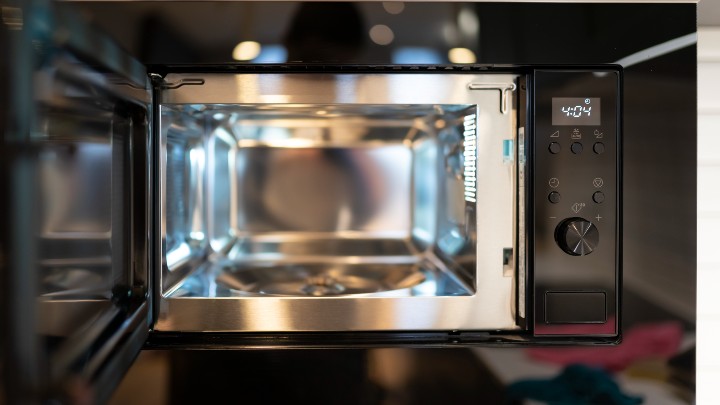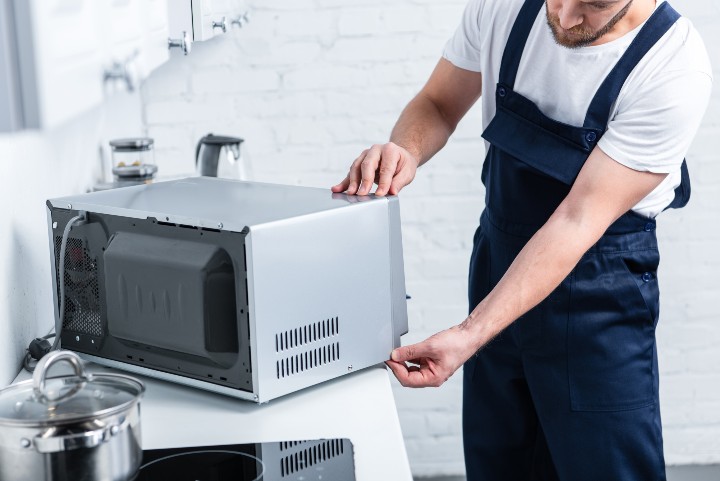Want to share feedback? Contact us.
Most households consider microwaves a necessity in cooking food. However, due to overuse and length of time using it, the microwave door is one of the significant parts that break down.
This article will show you if a microwave is still safe to use if you have a broken microwave door.
Here’s if It’s Safe to Use Your Microwave if the Door Is Broken:
The microwave door allows the user easy access to the inner cavity for placing or removing food plates. However, it serves a much more important purpose: it seals the microwaves inside the cooking cavity to protect the user from injury.
Microwave doors have seals along the edges to ensure a secure compartment is created when the door is closed. This keeps microwaves from leaking out the edges and causing burns.
A transparent piece of glass on the door of a microwave acts as a window, allowing the user to keep an eye on their food. This allows them to turn off the appliance if the food becomes too hot and threatens to explode or become ruined.
The window, however, is fitted with metal mesh to prevent microwaves from passing through the glass. The mesh holes are large enough to allow the user to see into the cooking cavity while remaining small enough to prevent microwaves from passing through.
The microwave oven is not safe to use if the door is either removed, missing, or not closed. The door contains two safety features: the shield in the door itself and the activation latch, which will not allow the oven to operate unless the latch is closed.
On the other hand, microwaves have a safety mechanism that prevents them from turning on or heating anything while the door is open.
Perhaps you have noticed that you accidentally pressed the start button while the door was open, and nothing happened. This is the microwave at work. To get the microwave to work correctly again, you need to replace the door.
Even though it would almost certainly not work with the door open, it would be dangerous to use if it did. Microwave radiation can heat both body tissue and food. This could result in eye and testicular injuries and internal burns. Pets in the vicinity would be in much greater danger.
If a microwave is used with the door open or removed, it will automatically restart when the food is finished, and the door is opened or discarded if the door is damaged. To ensure a tight seal, clean the door cavity with a rag and a mild detergent.
If you broke your microwave door, it would not turn on unless you manually placed the plastic latch attached to the door in the receiving slot – this is a fail-safe device built into microwaves to prevent leakage if such an event occurred.
When the door is open, a hook on the door (disengaged) meets a set of microswitches as the door closes (engages) through an opening in the housing and makes a positive closing sound, allowing further operations to proceed.

How to Replace a Broken Microwave Door?
Locate the specific make and model of your microwave before beginning any repairs. If you do not have the owner’s manual handy, this information can sometimes be found on the back or bottom of the microwave unit or printed just inside the microwave door.
Once you have determined the model, you can order replacement parts. If you have the owner’s manual, it may contain a part number that you can use as a reference when looking for a new door – which can generally be purchased through the manufacturer’s website for newer models and Amazon or a specialty website for older models.
Preparation
Remove the glass tray from inside the microwave and, most importantly, unplug the unit once you have the replacement parts. To remove a built-in or over-the-range microwave from its support bracket, you may need to remove mounting screws or retention clips. Place the microwave on a table or workbench and check if the door hinges are blocked by a grill or the microwave door’s interior panel.
If your microwave is mounted, you must remove it. Begin by prying open the front cover panel to access the mounting screws. Remove the screws with care and raise the microwave to counter-level.
Place your microwave on a safe work surface. This could be your counter, kitchen table, or wherever you feel most comfortable working with tools, standing, or sitting.
The microwave is now ready for repair. Removing the door is delicate work, but anyone with a steady hand can do it.
Door Removal
Begin by extending the microwave door as far as it will go. You must first gain access to the inner panel and then the hinges.
Insert a putty knife or flathead screwdriver carefully into the seam inside the microwave door. This seam should wrap around the door, connecting the inner panel to the main door structure. The hinge mounting screws are also hidden behind that panel.
Feel around the edge with your putty knife and release the mounting clips hidden inside one by one. Be extremely cautious, as these clips are made of thin plastic and are prone to breaking. Of course, you are about to toss this door, so do not be concerned if one or two of them snaps.
Once the clips are released, pry the door panel away from the rest of the door with a putty knife or screwdriver. Set this to the side.
You should now be able to see the microwave’s hinges. Examine the mounting pins while keeping the door wide open. Brace the door or have a friend hold it in place while you pry the mounting pins out of place. This should open the microwave door, and it is much easier to do if you keep the door level while working.
Finally, remove the broken microwave door from the unit. You can either dispose of the door and inner cover or keep them for your use.
New Door Installation
After you’ve removed the old microwave door, you’re ready to install the new, unbroken microwave door.
Begin by taking out all of the packagings from the new microwave door. Pull out all wads of paper or plastic that may be tucked in crevices, hinges, or underneath plastic door latches.
Place the new microwave door in place and align it with the hinges of the appliance. It should perfectly fit in the space where the old door was removed.
While you reattach the mounting pins, have a friend hold the microwave door steady. You may be able to achieve the same ease by propping up the door or deftly handling the door with one hand while holding mounting pins in the other. However, it is much easier with a friend.
Once the new door is securely fastened to the hinges, press the inner door panel into place to cover the hinge pins once more.
Microwave Testing
Several times, open and close the door. Check that it fits snugly, latches securely, and pulls open with the same ease as your previous door. Alternatively, even better, given that it is cleaner and not broken.
Check to see if the microwave recognizes the new door and functions properly. Plug in the microwave, replace the glass plate, and see if it works.
If the light turns on and the plate spins, you have just completed one of the more difficult non-electrical home appliance repairs. Pack your tools and yourself on the back.
Repairing your microwave is a thrilling experience, but not all repairs are as simple, and not everyone has the time or skill to perform their repairs. If your microwave is not working properly and you do not have the time or ability to repair it at home, communicate with the service center regarding your issues.

Is It Worth Replacing a Broken Microwave Door?
If your microwave is new and the repair is less expensive than replacing it, it is worth the effort. However, if something significant is broken in a microwave, it is not worth repairing.
The first question is whether your microwave can be repaired and how much effort will be required to do so. If the repair seems simple or direct, then a repair is most likely your better option.
If a repair appears complicated, dangerous, or necessitates multiple stages of repair, it may not be worth your time. When deciding whether to repair something, the cost of replacement parts should be factored in.
You do not have to know which option is better for you right away. In many cases, you will not know the actual cost of an appliance repair until you have had it inspected and spoken with a technician.
Appliance repair technicians now understand how to quickly and safely disassemble an appliance and test each of its critical components. They also frequently stock common replacement parts or provide a quote on parts that must be ordered.
You can quickly determine whether your microwave needs to be replaced or repaired with the assistance of an experienced appliance repair technician. You will then either agree on a plan to repair your microwave or begin searching for a new one. Use this time to consider what features you might want in a new microwave and how you can improve your current kitchen experience.
Sources:
Appliance Repair Specialists
The Home Mantra
Fred’s Appliance
Bike Hike
